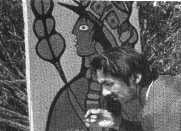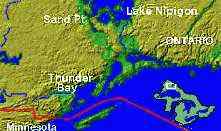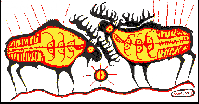 |
|---|
Biography

|
Norval Morrisseau: Biography |
 |
|
|---|---|---|---|
Morrisseau, 20 years ago, photographed outdoors with painting |
Click map for Reserve info |
||
| Page Buttons |
|
Norval Morrisseau is founder of a Canadian-originated school of art called Woodland or sometimes Legend or Medicine painting. His work is influential on a group of younger Ojibwe and Cree artists, such as Blake Debassige, Tom Chee Chee, Leland Bell. He has had many exhibits in Canada and Europe (especially France), but is not well known (except to northern Indians) in the U.S. This may change; recently Morrisseau had an exhibit and well-attended showing at the McLeod-Maslak Canadian Art Gallery in Santa Fe, the heart of what's trendy in U.S. Indian art.
Grandfather Potan was a Midewinini and Jissakan -- shaking tent seer. Norval learned stories, myths, spiritual things from his grandfather while growing up. He gained only a 4th-grade education at the Indian boarding school in Ft. William (now Thunder Bay). Back on the reserve he explored old sites and canoe routes, paying particular attention to petroglyphs or rock art. Whn he tried to paint his thoughts, dreams and visions, older people told him not to. When he was 19, he got tuberculosis -- a common and often fatal disease among Indian people. He was sent to a long-trm care hospital at Ft. William, where one of the doctors encouraged him to paint. At the hospital, he met Harriet Kakegamic, Cree. They were married and had 6 children before the marriage broke up. Still at the hospital, Morrisseau had a series of dreams and visions that he said were calling him to be a shaman-artist. "My paintings are icons, that is to say they are images which help focus on spiritual powers, generated by traditional belief and wisdom." Below is an early painting in this style, "Two Bulls Fighting,". The Glenbow Museum owns it. The x-ray anatomy of each bull moose is shown.  Here is the x-ray anatomy, the spirit power lines radiating from the spines of the animals, and the ball of radiant spirit power that appears between them which may represent the Miigis -- explained later). These -- in greater complexity -- are features adopted by most painters of the Woodland School. These features can all be found -- not with this artistic elegance -- on birchbark scrolls of Midewiwin rites, and song mnemonics. Some features of this kind of are roughly suggested in the rock petroglyphs, found all over North America, but in certain styles, over the Canadian Shield and Great Lakes woodlands, though these have received almost no attention in comparison with petroglyphs of the Southwest.
This led to jealousy among tribal members who criticized Morrisseau for revealing the tribe's legends and beliefs in the paintings. (Since the paintings speak to the emotions but not in words, they may be based on legends and myths, but don't actually narrate anything.) Probably the cricitism stemmed mostly from Morrisseau's book Legends of my People, the Great Ojibway,, edited by Dewdeney, Toronto, Ryerson Press, 1965, (long out of print). Morrisseau defended himself, saying he wanted to restore cultural pride to the largely catholicized people. Indeed, the visual language he devloped has spoken powerfully to artistically inclined Woodland Indians all over the north. One of the saddest things, for those who love art that speaks strongly to them, is to see our talented Indian youth from up heere start to develop a visual languag based on this ancient iconography that Morrisseau brought to light. Then they get scholarships to go study in Santa Fe, and come back (if at all) painting in an imitation of R.C. Gorman (very successful Navajo painter, a kind of stylistic doyen of Santa Fe Native art instruction), having lost access to the visions and visual language of the north in the chase for gallery success. As his artistic reputation grew, Morrisseau donated paintings to raise money for the Indian school and for other reserve needs of the people. Food, heat in winters. Morrisseau is himself a Catholic and has gone through many personal struggles to try to reconcile his faith with his Native beliefs. He's been a wanderer and often had severe drinking crises. In 1976, he adopted the Eckankar religion with its belief in astral soul travel, which he said then resembles Native religious teachings (it really REALLY REALLY doesn't). I didn't know what it was either, but you can find out anything on InterNet. And Holy slimoley! The golden Temple of Eck (built 1984) is in Minnesota, a suburb of Minneapolis! And for Morrisseau's convenience, they got one in Saskatoon, and I bet they're loaded with 'em in BC, Canada's California. I went all through the Golden Temple of Eck (webwise) to see if any of his paintings was there -- Nope, they got just the ugliest portraits of Past Grand Sri Mhanranis (forgot the word). I'm gonna try that HU-HU-HU spiritual exercise, hey-hey-hey-ahey. There seems to be a whole lot of Ecks in Germany, but their web pages is all in German. Norval! That's the wrong kind of Indians! Reverse mistake of Columbus or something. He suffered severe burns in 1972, in a hotel fire in Vancouver, and for several years after, while staying in a Catholic-run BC detox center, painted a great deal of Roman Catholic imagery. In effect, these paintings recast Christian iconography to show all the cast of characters as Indians.
He presently lives in British Columbia, and is represented by several galleries in Canada. Representation and showing in the U.S. is a very recent new development. Many Indian youth have been interested in Medicine or Legend painting, either from direct introduction to Morrisseau's works or through the second and third generations of Woodland painters, but these are impossible to find in U.S. museums and books (some Indian individuals have a few).
|
|---|
Menu |
MENU |
MENU |
|---|
Text and graphics copyright 1995, 1996
Last Updated: Saturday, August 03, 1996 - 7:28:42 AM